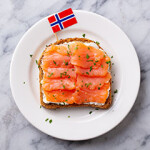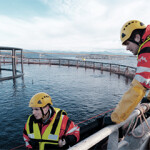Aquaculture provides way forward for Crimea

Nearly surrounded by the Black Sea and the Sea of Azov, the Crimean Peninsula has a rich seafood history.
But in March 2014, when it was then a part of the Ukraine, it gained the world’s attention for a different reason, when the Russian military entered the peninsula, held a disputed referendum, and moved to annex the territory as a Russian federal subject.
SeafoodSource is taking a deeper dive into Crimea’s seafood industry with a two-part series. Part 1 looked into how hopes that the Russian annexation might revolutionize Crimea’s wild-catch fisheries have not yet materialized. Part 2 investigates efforts at building up the regional aquaculture sector.
Aquaculture has breakthrough potential
If for no other reason than that they thought it would be good for business, regional seafood companies generally supported Russia annexation of Crimea in 2014. They saw easier access to the 140 million consumers in the Russian market as a boon, and they eagerly eyed the potential that deeper-pocketed Russian investors might bring to them.
But despite efforts by the Russian government to jump-start Crimea’s wild-catch sector, the peninsula’s catch totals have stagnated since 2014. Now, many are looking to aquaculture as the path forward for growing the region’s seafood industry.
Before the annexation, Crimea’s aquaculture sector consisted of 19 companies concentrating on farming coarse fish, mussels, and oysters. Its output was 572 MT in 2013. But the region’s aquaculture potential is high: The length of Crimea’s shoreline is 2,500 kilometers, and its 1,959 inland water bodies are a combined 56,587 hectares, including 23 water reservoirs, 1,872 lakes, and 64 ponds.
With wild-catch production in the entire Azov Black Sea basin hitting a ceiling in recent years of around 75,000 metric tons, aquaculture shows much more promise than the fishing industry at experiencing growth in coming years, according to Ilya Bereznyuk, the managing partner of Agro and Food Communications, a Russia-based consultancy,
“Concentration of salt in the waters of the Black Sea is optimal for farming fish and shellfish, there are enough depths and currents for aquaculture. All these factors make it rather attractive place for investments, and investors are going to make more money in mariculture than in fishing,” Bereznyuk told SeafoodSource.
The region’s natural advantages, combined with the normalization of business conditions after the turmoil of the annexation, have already started to translate into improved commercial results, Bereznyuk said.
According to the Director of Department of Agriculture of Sevastopol Dmitry Chumakov, the local aquaculture industry increased its output by 50 percent between 2017 and 2018. In the first half of 2018, the production of farmed seafood increased twofold year-on-year, from 108.6 MT to 229 MT, with shellfish representing majority of the increase. As of the middle of 2018, 69 companies are now operating in Crimea’s aquaculture sector, three times more than five years ago. In 2018, Crimean farmers sold 174 MT of oysters, up 45 percent over a year before, and the output of mussels increased by 10 percent to 33.6 MT.
At a 2018 press conference to discuss the development of aquaculture on the peninsula, Deputy Head of the Russian Federal Agency for Fisheries Vasily Sokolov said the government’s expectations for the sector have already been exceeded, and that hopes were high for the future.
“We count on exponential growth in aquaculture,” Sokolov said.
Sokolov cited the success story of Azov Son Sturgeon Company, which is now in the process of expanding its operations to produce 1,000 MT of mussels and 5.5 million oysters a year. The project is expected to be completed in the next year or two.
Sokolov said in the next year, in an effort to continue the growth trend, the Fisheries Agency will sell up to two dozen new permits for aquaculture operations in the region.
Struggles with investment
Since the annexation, local authorities have repeatedly said they want to see more investors come into the seafood sector.
Ilya Bereznyuk, of Agro and Food Communications, said investment spending goes a long way in Crimea and has a large potential for profit.
“Investments of up to RUB 50 million (USD 777,000, EUR 688,000) are enough to launch a facility with an annual capacity of 750 MT mussels,” he said. “This business requires specific knowledge and hiring foreign specialists, but the sum of investment is affordable for even medium- and small-sized companies.”
However, due to sanctions imposed by many countries, including the United States and the European Union, on companies that seek to do business in Crimea, most potential investors have steered away.
Nevertheless, Andrey Dedyukhin, chairman of the Fisheries Committee of the Republic of Crimea, is convinced the local aquaculture sector will continue to flourish.
“The years to come will see further growth in production,” he said.
Oysters, in particular, have proven to be a winner, with production expected to increase by 30 percent annually, he said at a 2018 press conference.
Bureaucracy a barrier
Another major barrier the Crimean aquaculture industry faces is Russian bureaucracy, which thus far has presented the biggest stumbling block for prospective investors.
The area of Crimea with the most promising potential for mariculture are the near-shore waters in the Black Sea. But due to the historical importance of tourism in the region, many of the most prime spots have been reserved for resorts, and tourism-related development continues to receive priority in the permitting system in Crimea.
Another problem stymying the growth of mariculture is explosive in nature. In World War II, the Crimean Peninsula was a major battleground, and there are an untold number of mines, bombs, and other dangerous materials intact on the seabed, Vladimir Gaydaenko, head of Department of Fisheries and Aquaculture of the Republic of Crimea, said in an interview with TV channel Crimea.
Even securing a permit and location for aquaculture activities is no guarantee for an investor that a project will succeed. Sergey Tatko, an entrepreneur from Saint Petersburg, relocated to Crimea soon after the referendum in March 2014. He bought the rights for an aquafarm in the Black Sea near Sevastopol and received a permit to produce 1,000 MT of mussels and 2.5 million oysters annually. Tatko had plans to harvest his first mussels in October 2019 but has thus far been unable to obtain a sister permit for the establishment of his processing facilities, he told the Meduza news site. Nine times, he has pursued a land acquisition, but each time, he has been unable to complete the deal, he said.
“Some of the refusals I obtained after the Sevastopol’s governor ordered his administration to help me as much as possible,” he said.
Tatko has thus spent RUB 40 million (USD 621,000, 551,000 EUR) on the project without an end in sight, he said.
Tatko said he was infuriated when another seafood company that had bought a spot near his faced the same problems and eventually ceased any attempts to find a solution.
“I even wanted to buy an advertising billboard in St. Petersburg reading, ‘Forget about investments into Crimea! Putin’s laws and orders don’t work here!’” Tatko said.
In the event Tatko does not receive permission to start processing on land, he has made plans to do on-the-water processing, but it will make his business less profitable, he said.
Another cautionary tale is that of the Krym-Agro company, which sought to establish the first closed-cycle shrimp farm in Russia with an investment of RUB 1 billion (USD 15.5 million, EUR 13.8 million). The project had set the goal of producing 18 million shrimp hatchlings a month in its first phase, and its owners had hired scientific specialists from the United States and China to serve as advisors on the project.
But in April 2019, a scandal erupted over the construction of the shrimp farm, which was initially supported and promoted by the regional Crimean government. Residents in the area where the construction process was to begin initiated protests that gathered steam and public support, eventually succeeding in derailing it.
The fact that the Krym-Agro company had already obtained all necessary approvals and permission from local and regional authorities for the project and still failed in its efforts to see its project through to completion is likely to have given other investors second thoughts about investing in the sector.
While both local officials in Crimea and representatives of Russia’s national government outwardly continue to express confidence that the future for aquaculture in the region is bright, significant barriers still exist that prevent the sector from reaching its full potential.
Despite the rosy picture the Russian government paints of how its influence is helping to steer the Crimean economy in a better direction, the results of its efforts to boost the Crimean seafood industry show that much work remains to be done before it can call the project a success.






Share